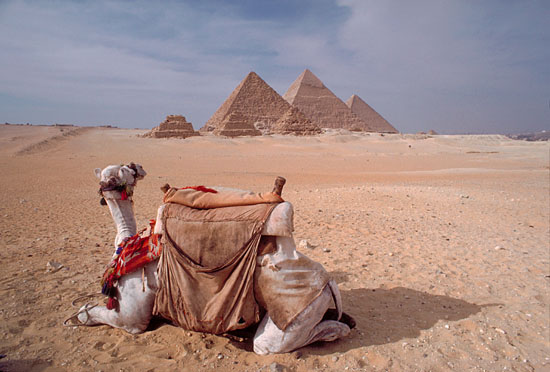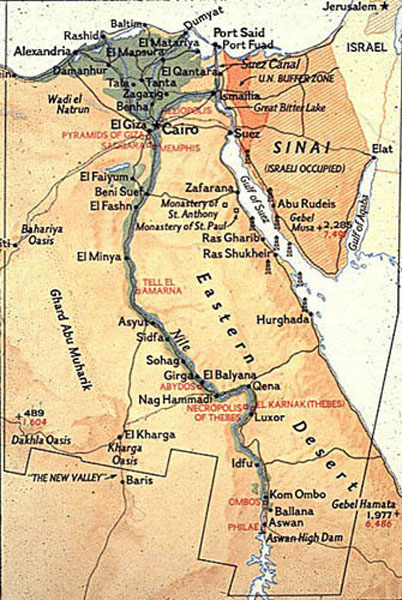|
The Nile is the
longest river in the world (about 6,650 kilometers) and flows north from
east-central Africa to the Mediterranean Sea. Its flood plain was an
extensive oasis for life -- human, plant and animal. The annual flooding
of the Nile deposited nutrient rich silt on the land, creating all the
ingredients needed to support life and the growth of a great civilization.
Bounded on the south, east and west by a impenetrable desert, and on the
north by the sea, ancient Egypt was protected from outside influences,
which allowed it to evolve in its own unique way.
The Nile River was created millions of years ago when an ancient sea that
covered most of Europe and northern Africa (45 million years ago) shifted,
forming the Mediterranean Sea basin. Over thousands of years, the Nile
River evolved into its present shape, surrounded by the Eastern and
Western deserts. The Upper Nile (southern) is divided into three
tributaries: the White Nile, the Blue Nile and the Atbara River. The White
Nile flows from Lake Victoria, Lake Edward and Lake George, and the Blue
Nile originates in the Ethiopian mountains. The Atbara River flows from
the Ethiopian highlands and meets the combined White Nile and Blue Nile
just north of Khartoum. Before the river enters the Mediterranean Sea, it
divides into four smaller tributaries in the delta region. The northern
region of Egypt is bounded by two deserts, the mountainous Eastern, or
Arabian, Desert and the sandy Western, or Libyan, Desert. About 5000 years
ago communities along the Nile were concentrated in the north and the
south. As a result, Egypt became known as the two lands of Upper and Lower
Egypt. The two lands were united in 3100 BC by Egypt's first pharaoh --
King Narmer (Menes). His capital was in the northern delta (Lower Egypt)
and was called Memphis (Mennefer). It remained, intermittently, the
capital of Egypt for over 2,000 years. Just north of Memphis, near the
junction of the delta with the main Nile is the modern capital and largest
city in Egypt today -- Cairo. Saqqara and Giza (the site of the Great
Pyramids) are not far from Cairo.
About 2/3 the way south from the Mediterranean Sea to the Egypt-Sudan
border is Abydos. Just south of here the Nile makes an acute bend. At this
point is the city of Luxor (also called Thebes). Thebes was the capital of
the Middle and New Kingdoms. It is here on the eastern bank of the Nile
("the land of the living", where the sun rises) where the great temples of
Karnak and Luxor are located. On the western side ("the land of the dead",
where the sun sets) are the tombs (Valley of the Kings and Queens and
Queen Hatchepsut's mortuary temple). Further south are the temples at Edfu,
Kom Ombo and Phillae. In the extreme south near the Sudanese border the
river is partially blocked and controlled by the Aswan High Dam. The
result is Lake Nasser. Nearby are the magnificent monuments of Abu Simbel
built by Ramses II.
Attractions in the Nile Valley
Egyptian Museum of Antiquities
The present museum was built in 1900 at Cairo, in the
neo-classical style by the French architect Marcel Dourgnon. This museum
exhibits over 120 000 objects. Some of the important groups of these
objects are:
The mummies of many of the pharaohs of the Old, Middle and New Kingdoms.
Artifacts from their tombs and those of other royal family members are
also displayed. Besides these, objects from the royal and private tombs at
Tanis (in the Delta) dating from the 21st and 22nd Dynasties, the Amarna
Period and the royal palaces may be seen. The largest collection in the
museum, occupying most of the second floor is of Tutankhamon. Artifacts
from his tomb (including his famous gold mask and sarcophagus) consist of
more than 3500 pieces, of which 1700 objects are displayed in the museum.
Great Pyramids of Giza
The Pyramids of Giza and their guardian Sphinx are regarded as one of
the Seven Wonders of the Ancient World. The largest (Great Pyramid) was
built by King Khufu (Cheops in Greek, ruled 2551-2528 BC) and covers an
area of 13 acres. Its original height of 146 meters has now become 137
meters after the erosion of its summit. It consists of two million blocks
of limestone ranging in weight from 2.5 tons to 15 tons. The Second
Pyramid was built by King Khafre (Chephren in greek, ruled 2520- 2494 BC).
At its apex are traces of the outer limestone casing that once covered all
of the Pyramids. The Third Pyramid of Menkaure (Mycerinus in Greek, ruled
2490 - 2472 BC) is smaller in size than its predecessors and was never
finished. Its height is 62 meters. Carved into the rock near the Pyramids
are spaces where large wooden boats were stored to be used in the
afterlife.
The Great Sphinx
The sphinx appears to have started in Egypt in the form of a sun god. The
Great Sphinx at Giza has the head of a king wearing his headdress and the
body of a lion. There are, however, sphinxes with ram heads that are
associated with the god Amun. The Great Sphinx is 500 yards from the
Chephren Pyramid. Chephren's workers shaped native stone into the lion and
gave it their king's face over 4,500 years ago. The sphinx faces the
rising sun. It is is built of soft sandstone and would have disappeared
long ago had it not been buried for so long. The body is 200 feet (60m) in
length and 65 feet (20m) tall. The face of the sphinx is 13 feet (4m) wide
and its eyes are 6 feet (2m) high. Part of the uraeus (sacred cobra), the
nose and the ritual beard are now missing. No one can be certain who the
figure is to personify. It is possible that it is Chephren. If that is so,
it would then be the oldest known royal portrait in such large scale. The
image of the sphinx is a depiction of royal power, only a pharaoh or an
animal could be shown this way.
Saqqara
Sakkara is found near the great necropolis of Memphis -- the Old Kingdom
capital. It is best known for the Step Pyramid, the oldest known of
Egypt's 97 pyramids. It is believed to have been created by the
architect-astronomer-high priest: Imhotep, for Pharaoh Djoser (Zoser)
(2667 - 2648 BC) -- the second ruler of the 3rd Dynasty. The complex is
thought to represent the first major stone pyramids. The royal tomb is 28
meters underground with a vertical shaft leading to it. The entrance was
sealed with a 3 ton piece of granite. The process to make it a true step
pyramid was begun when over 200,000 tons of stone was used to add another
two tiers to the original structure. An extra two tiers were added above
these four to make it into the six-tiered pyramid which we see today. A
Tura limestone face was finally added to create a smooth exterior surface
for the pyramid (most of this is missing today). Within the structure was
a blue-tiled tomb chamber and a statue of Pharaoh Zoser.
Memphis
Memphis, the oldest capital of Egypt, lies 24 kilometers southwest of
Cairo at Al. Badrasheen. Here you can find a large statue of Ramses II
exhibited in a small museum. This is one of the most beautiful
representation of Ramses II. lt is made of fine grained limestone -- 13
metres long and weighing 120 tons.
Not far away is the Alabaster Sphinx of King Tuthmosis lll and the Temple
for Embalming the Sacred Apis Bull, which shows the various steps of
embalming.
Luxor
Today's Luxor is part of ancient Thebes: 'the one hundred-gated city' as
it was called by the Greek historian, Homer, because of its buildings and
large gates. Years later the Arabs, impressed by its beautiful edifices,
re-named it 'Luxor': City of Palaces. Luxor remained the seat of Egyptian
power from 2100 to 75 BC. The city is made immortal by its huge
pillared-monuments along both banks of the Nile. On the east bank (where
the life-giving sun rises) is the 'City of the Living'. Here are the
Temples of Luxor and Karnak. On the west bank (where the sun sets) is the
'City of Dead' where one finds the Colossi of Memnon, the tombs of the
Valleys of the Kings and Queens, the tombs of the Nobles, and Queen
Hatshepsut's mortuary temple (Deir al-Madina).
Karnak
The Temple of Karnak -- considered by some the greatest place of worship
in history -- was built and enlarged over a thirteen hundred year period.
It is actually three main temples (dedicated to the gods Mut, Monthu and
Amun), some smaller enclosed temples, and several outer temples. The major
divisions of Karnak are separated by six enormous brick walls called
pylons. The main complex, The Temple of Amun, is situated in the center of
the entire complex. The Temple of Monthu is to the north of the Temple of
Amun, while the Temple of Mut is to the south. The Hypostyle Hall is found
after passing through the Second Pylon. The hall is considered to be one
of the world's greatest architectural masterpieces and was started during
the Nineteenth Dynasty by Ramesses I. The work continued under Seti I
(1306 - 1290 BC) who also built the Temple of Abydos to the north. The
hall was completed by Seti's son, Ramesses II. The hall ceiling was 82
feet high and was supported by 12 papyrus-shaped columns. The columns are
made of sandstone and set in two rows of six. Each row is flanked on
either side by 7 rows of columns that are 42 feet (12.8m) high. Each row
has 9 columns, however the inner rows have 7 columns. The reliefs
throughout the hall contain symbolism of Creation. The outer walls of the
Hypostyle Hall are covered with scenes of battle, but have long since lost
their painted color. The Transverse Hall lies beyond the rear wall of the
Hypostyle Hall and is mostly in ruin. Within the Transverse Hall is a
partially reconstructed Third Pylon of Amenhotep (Amenophis) III. The
Transverse Hall has remains of the earliest sections of the Karnak complex
that are still in existence. Leaving the Hypostyle Hall through the third
pylon you come to a narrow court where there once stood several obelisks.
One of the obelisks was erected by Tuthmosis I (1504 - 1492 BC) who was
the father of Queen Hatshepsut. This obelisk stands 70 feet (21.3m) tall
and weighs about 143 tons. Beyond this obelisk is the only remaining
Obelisk of Hatshepsut (1473-1458 BC). It is a 97 foot (29.6m) high pink
granite structure and the tallest at Karnak. The Sixth Pylon, which was
built by Tuthmosis III, leads into a Hall of Records in which the king
recorded his tributes. Very little of it remains today. Just beyond these
pillars lies the Holy of Holies sanctuary. Originally it was the oldest
part of the temple. The present sanctuary was built by the brother of
Alexander the Great, Philip Arrhidaeus (323-316 BC) who was the King of
Macedonia. The present sanctuary was built on the site of the earlier
sanctuary built by Tuthmosis III and contains blocks from the Tuthmosis
sanctuary and still contain Tuthmosis' inscriptions.
Valley Of The Kings
From about 1570 BC to 1070 BC the pharaohs abandoned the Memphis area and
built their tombs in Thebes. Also abandoned were the pyramid style tombs.
Most of the tombs were cut into the limestone following a similar pattern:
three corridors, an antechamber and a sunken sarcophagus chamber.
Construction usually lasted six years, beginning with the new reign. The
text in the tombs are from the Book of the Dead, the Book of the Gates and
the Book of the Underworld. Some of the tombs found here are of Tuthmose
II, Amenhotep II, Tutankhamun, Seti I and Ramses III, IV, VI and IX.
Queen Hatshepsut's mortuary temple
The setting for the mortuary temple of Queen Hatshepsut is one of the most
dramatically situated in the world. It is set in a valley at the base of
the Peak of Thebes ("Lover of Silence") where lived the goddess who
presided over the necropolis. A tree lined avenue of sphinxes led up to
the temple, and ramps led from terrace to terrace. Reliefs on the south
side of the middle terrace show the queen's expedition by way of the Red
Sea to Punt, the land of incense. Along the front of the upper terrace, a
line of large, gently smiling Osirid statues of the queen look out over
the valley. In the shade of the colonnade behind, brightly painted reliefs
decorated the walls. Throughout the temple, statues and sphinxes of the
queen predominate -- many of them have been reconstructed.
Temple of Edfu
This temple from the Ptolemic period is devoted to the falcon-like sun god
Horus. It is located at the town of Edfu, 123 kms north of Aswan.
Temple of Philae
The Temple of Philae was dismantled and reassembled on Agilika Island
about 550 meters from its original home on Philae Island. This
reconstruction was done because of flooding caused when the Aswan High Dam
was built. The temple, dedicated to the goddess Isis, is in a beautiful
setting which has been landscaped to match its original site. Its various
parts include The Vestibule of Nectanebos I (its entrance), the Temple of
the Emperor Hadrian, a Temple of Hathor, Trajan's Kiosk (Pharaohs Bed), a
birth house and two pylons celebrating all the deities involved in the
Isis and Osiris myth. Although antiquities on the island date between the
26th Dynasty and the Roman Period, most of the work is from that of the
Roman.
Abu Simbel
There are two temples (Greater and Lesser) at this southernmost Abu Simbel
location. The first and largest is of Ramses II and is dedicated to the
sun god Ra-Harakhte. The second,which is slightly smaller and just a few
meters to the north is of Nefertari (Ramses II's wife) and dedicated to
the goddess Hathor.
The Greater Abu Simbel Temple is one of the many relics erected by the
Pharoah Ramses II and is considered his grandest and most beautiful
monument. The facade is 33 meters high, and 38 meters board, and guarded
by four statues of Ramses II, each of which is 20 meters high. Near the
top of the facade is a carved row of smiling baboons. On the doorway of
the temple, there is a beautiful inscription of the King's name : Ser-Ma'at-Ra;
and between the legs of the colossal statues on the facade, you can see
smaller statues of Ramses II 's family: his mother "Mut--tuy", his wife "Nefertari"
and his sons and daughters. Inside the temple is the Great Hall of
Pillars, with eight pillars bearing the deifed Ramses II's in the shape of
Osiris. The walls of this hall bear inscriptions recording the Battle of
Kadesh waged by Ramses II against the Hittites. Further inside is the
smaller hall of the temple -- the hall of the nobles, containing four
square pillars. Then comes the innermost room -- the "Holiest of Holies",
where four statues are found: gods Ra-Harakhte, Ptah, Amun-Ra and King
Ramses II. This temple is unique, since the sun shines directly on the
Holiest of Holies two days a year : February 21, the King's birthday, and
Ocober 22, the date of his coronation.
Because of flooding caused by building the Aswan High Dam, the temples had
to be cut up and moved to
higher ground in 1959. |


